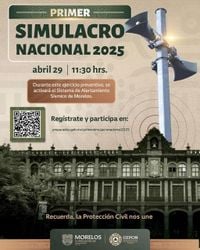On Tuesday, April 29, 2025, at 11:30 AM, Mexico will conduct its First National Drill 2025, a massive exercise aimed at testing the nation’s preparedness for natural disasters. This drill will engage over 7 million people and involve 89,000 properties across the country, reinforcing the culture of prevention and response to emergencies.
The National Civil Protection Coordination (CNPC) has confirmed that during the drill, a seismic alert will sound nationwide, utilizing multiple channels to ensure widespread awareness. This includes activating 14,491 public speakers, broadcasting alerts via national radio and television, and sending text messages directly to mobile devices.
The scenario for this year’s drill is a hypothetical earthquake measuring 8.1 on the Richter scale, with its epicenter located in the Gulf of Tehuantepec. This region is known for its seismic activity and is expected to affect primarily the southern and central states of Mexico.
In addition to the earthquake simulation, the Secretary of the Navy (SEMAR) will conduct a tsunami alert exercise in the Pacific Ocean, further enhancing the country’s preparedness for various natural threats. According to Laura Velázquez Alzúa, the National Civil Protection Coordinator, the drill is essential for evaluating the effectiveness of alert systems and emergency protocols.
During the drill, individuals in Mexico City and surrounding areas will receive a specific text message stating: "#This is a drill #This is a drill. The seismic alert was activated on April 29, 2025, at 11:30 AM. Sensor near Tehuantepec, Oaxaca. #This is a drill #This is a drill." This initiative is part of a national project to centralize emergency alerts, similar to systems implemented in Chile.
The seismic alert will be triggered in twelve states, including Mexico City, State of Mexico, Guerrero, Oaxaca, Puebla, Jalisco, Colima, Michoacán, Morelos, Tlaxcala, Chiapas, and Veracruz. Citizens are encouraged to participate actively, as their involvement can significantly enhance the effectiveness of emergency protocols.
To officially participate in the drill, individuals and institutions can register through the platform simulacronacional.sspc.gob.mx/1ersimulacronacional2025. Registration allows participants to identify evacuation routes, access specific emergency plans, and receive an official participation certificate upon completion of the exercise.
Fausto Reyes Delgado, the medical director of UNAM-Banfield Veterinary Hospital, emphasizes the importance of including pets in emergency plans. He states, "Participating in drills allows us to measure action times, reaction, and coordination among neighbors and authorities, who could assist pet owners during confusing moments." As such, pet owners are encouraged to prepare their animals for emergencies by ensuring they have identification tags and a pet emergency kit.
Essential items for a pet emergency kit include vaccination records, necessary medications, food for at least one day, and a favorite toy to provide comfort during stressful situations. Reyes Delgado reminds pet owners that caring for a pet is a long-term responsibility, and including them in emergency plans is crucial for their safety.
The Mexico City Metro system will also activate its emergency protocols during the drill. At 11:30 AM, the seismic alert will sound across the capital, and trains currently in operation will halt for three minutes to ensure safety. Metro staff will conduct infrastructure inspections during this time.
Users are advised to stay calm, follow instructions from Metro personnel, and identify safe zones, such as walls and ticket offices. The Metro has highlighted the importance of knowing emergency procedures, even though its stations are considered lower-risk areas.
As part of the drill, the National Emergency Committee, led by Secretary of Security and Citizen Protection Omar García Harfuch, will convene with the 32 governors of the country to evaluate the results and improve strategies for future emergencies.
In preparation for the drill, citizens are encouraged to familiarize themselves with emergency protocols, which can significantly reduce panic and improve coordination during real disasters. Participating in drills helps identify risks, assess response times, and refine evacuation plans, ultimately increasing the chances of saving lives and protecting property in the event of a catastrophe.
Moreover, the First National Drill 2025 is not just a test; it is a call to action for all Mexicans to engage in disaster preparedness. By participating, citizens contribute to a collective effort that enhances community resilience and fortifies the nation’s ability to respond to emergencies.
As the date approaches, the CNPC continues to stress the importance of public involvement. The drill serves as a reminder that preparedness can make a life-saving difference in real situations. With the participation of citizens, authorities, and various organizations, Mexico aims to strengthen its emergency response capabilities and foster a culture of safety and prevention.
In conclusion, the upcoming First National Drill 2025 represents a crucial opportunity for Mexico to enhance its disaster preparedness. By actively participating, citizens can help ensure that they, their families, and their communities are ready to face potential emergencies head-on.



